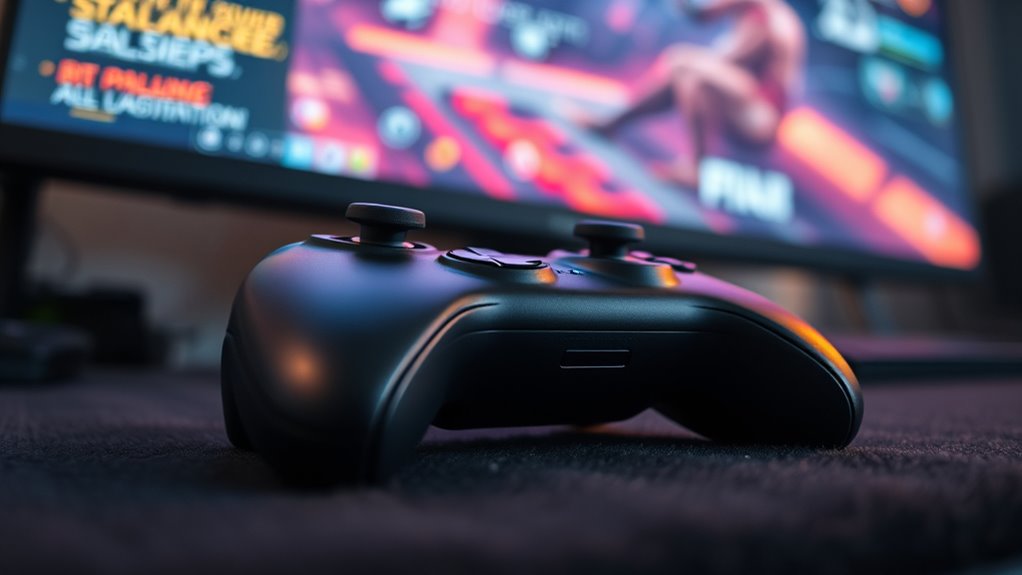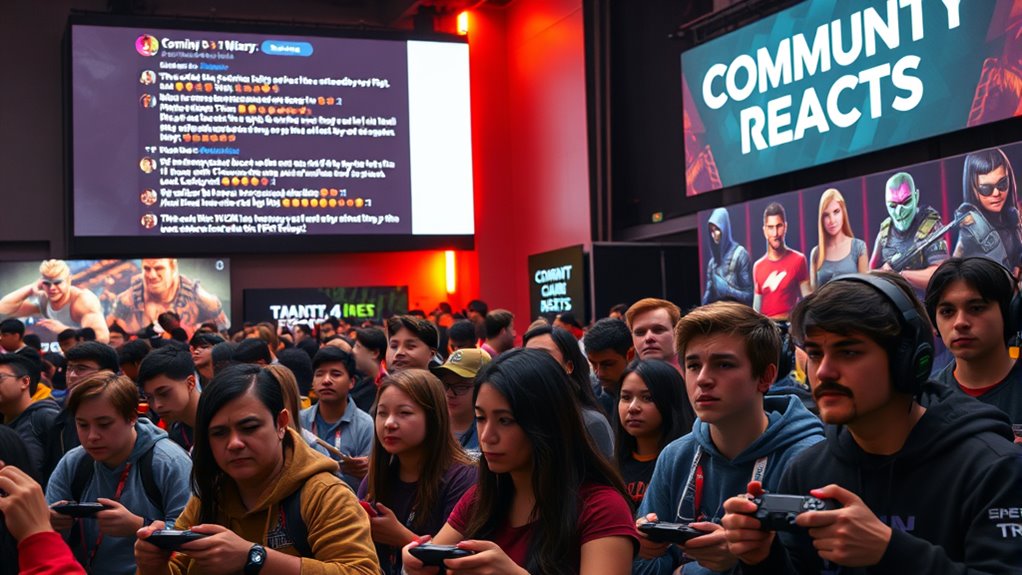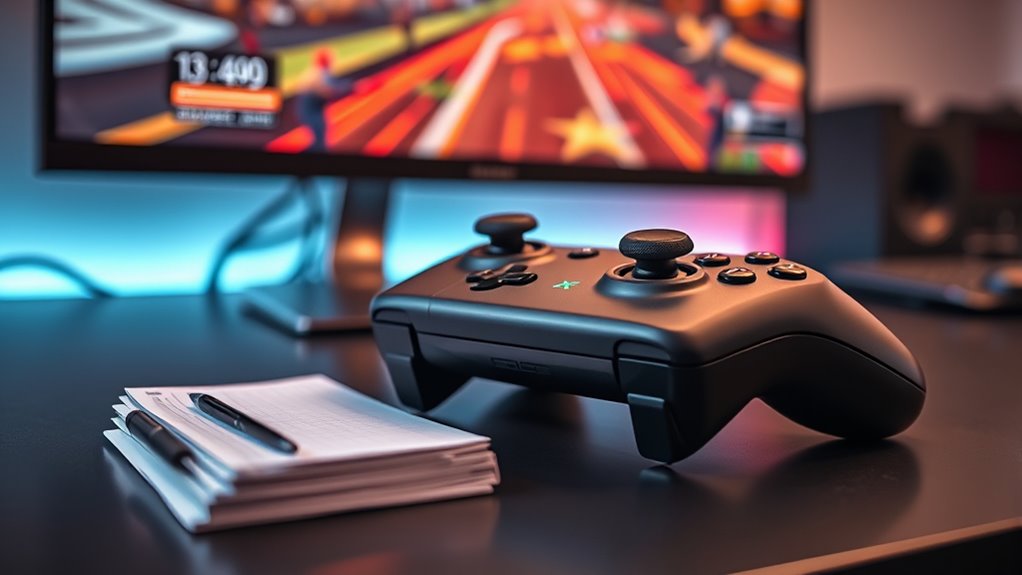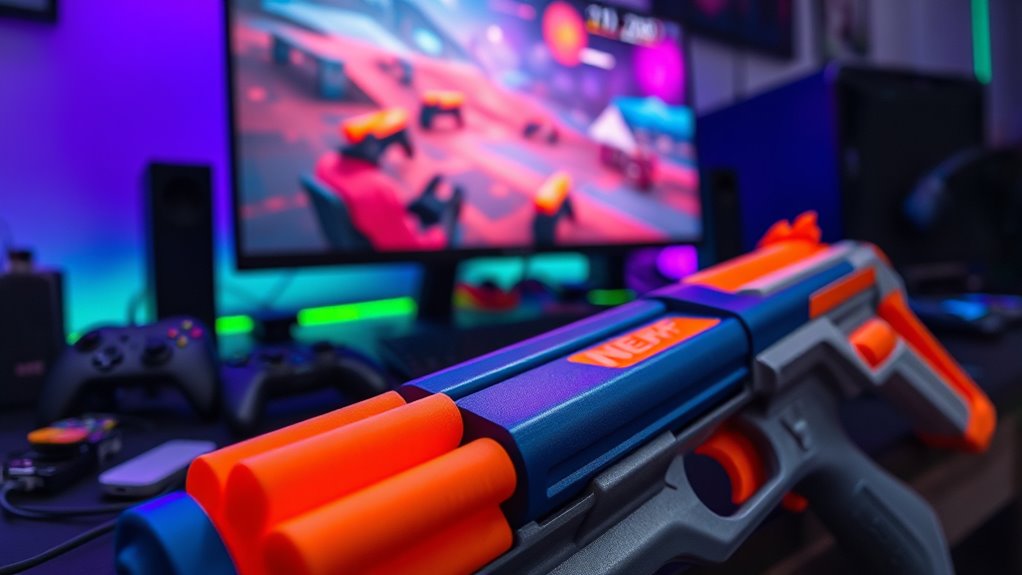In gaming slang, “nerf” means developers intentionally weaken a game element like a weapon or character to improve balance and fairness. This is often done after players find certain strategies overpowered, making gameplay less diverse. Nerfs help maintain competitive integrity and encourage varied tactics. If you keep exploring, you’ll discover how nerfs shape strategies, balance competitive play, and why they’re essential for keeping games engaging and fair for everyone.
Key Takeaways
- In gaming slang, “nerf” means to weaken or reduce the effectiveness of a game element like weapons or characters.
- Nerfs are implemented through updates to balance gameplay and prevent overpowered strategies.
- The term originates from the foam toy brand “Nerf,” symbolizing something made softer or less impactful.
- Developers use nerfs to promote fairness, diversity, and competitive integrity in games.
- Community reactions to nerfs vary, often prompting players to adapt new tactics or strategies.
The Origin of the Term “Nerf” in Gaming

Have you ever wondered where the term “nerf” comes from in gaming? It’s a common piece of gaming terminology, but its slang origins are pretty interesting. Originally, “Nerf” was a brand of foam toys, like foam balls and blasters, known for soft, safe play. Gamers adopted the term to describe when developers weaken a game element, like an overpowered weapon or character. The idea is that the item becomes “soft” or less effective, just like the foam toys. This analogy made “nerf” a perfect fit in gaming slang, capturing the concept of reducing power without removing it entirely. Over time, “nerf” became a widely used term to describe balancing adjustments in games, shaping how players talk about game updates today.
How Developers Use Nerfs to Balance Gameplay

Developers intentionally use nerfs to maintain fair and engaging gameplay by adjusting the strength of game elements that become too powerful or disruptive. This is a key part of game design, ensuring no single strategy dominates and players stay challenged. When nerfing, developers consider player psychology, preventing frustration or boredom. They analyze data to identify overpowered characters or items and then implement nerfs to balance the experience. Typically, this process involves:
- Reducing damage output or effectiveness
- Limiting resource availability
- Slowing ability recharge times
- Adjusting game mechanics for fairness
- Removing or weakening specific features
These changes help sustain competitive integrity, keep gameplay fresh, and foster a sense of accomplishment, all while respecting the diverse motivations and reactions of players. Additionally, understanding game balance is crucial for creating a dynamic and enjoyable experience for all players.
Examples of Nerfs in Popular Video Games

In popular video games, nerfs are often implemented to keep gameplay balanced and competitive. When developers release game patch notes, they frequently include tweaks that weaken overpowered characters, weapons, or abilities. For example, in a well-known shooter, a powerful weapon might be nerfed after players in the community complain about its dominance. Similarly, in a multiplayer online battle arena (MOBA), a hero’s damage output may be reduced to ensure fair play. These changes are typically reflected in official patch notes, which the player community closely follows. Nerfs aim to prevent any single element from overpowering the game, encouraging diverse strategies and maintaining an engaging experience for all players. Understanding the concept of game balance can help players better appreciate why nerfs are necessary for a fair gaming environment.
The Impact of Nerfs on Player Strategies

When a nerf changes a powerful weapon or ability, your gameplay dynamics shift instantly. You’ll need to adjust your strategies to stay competitive and effective. These updates force you to rethink tactics and explore new ways to succeed. Additionally, understanding the impact of contrast ratio on image quality can help players better evaluate in-game visuals and make more informed decisions during gameplay.
Shift in Gameplay Dynamics
Nerfs often force players to rethink their strategies, leading to a noticeable shift in gameplay dynamics. As you adapt, you’ll see changes like:
- Altered weapon or character effectiveness, prompting new tactics
- Increased emphasis on different abilities or roles
- Shift in preferred playstyles to compensate for nerfed assets
- Greater reliance on team coordination and communication
- Player feedback influencing future game patching decisions
These adjustments happen because developers listen to player feedback, which guides how they implement nerfs. Game patching then refines gameplay, balancing the experience and preventing frustration. This constant evolution keeps gameplay fresh, challenging you to find new ways to succeed and stay ahead in the ever-changing game environment. Additionally, incorporating AI-powered analysis can help players better understand the impact of nerfs and adapt more efficiently.
Strategy Adjustments Required
As gameplay evolves in response to nerfs, players must rethink their strategies to stay competitive. Nerfs force you to adapt quickly, prompting significant strategy shifts. You might need to explore new weapons, change your playstyle, or focus on different objectives. Player adaptation becomes essential to counterbalance nerfed features and maintain effectiveness. Here’s a quick look at how strategies can change:
| Nerfed Aspect | New Player Approach |
|---|---|
| Damage Output | Use hit-and-run tactics |
| Mobility | Prioritize positioning |
| Weapon Power | Combine with buffs or team play |
| Defensive Skills | Boost defensive maneuvers |
| Objectives | Focus on strategic control |
Additionally, understanding the game mechanics can help you develop more effective counter-strategies to adapt swiftly.
Differences Between Nerfs and Buffs

Nerfs and buffs serve different purposes in game balance; nerfs weaken overpowered elements, while buffs strengthen weaker ones. These changes directly affect gameplay balance and how players approach strategies. Developers also communicate these updates differently to keep players informed and engaged. Incorporating game balance adjustments helps maintain a fair and enjoyable gaming environment for all players.
Purpose of Nerfs and Buffs
In gaming, developers implement nerfs and buffs to maintain balance and guarantee fair competition. These adjustments aim to influence player empowerment and control game difficulty, ensuring no single strategy dominates. Nerfs typically weaken overpowered elements, preventing frustration and encouraging diverse playstyles. Buffs strengthen underperforming aspects, giving players more options and excitement. Additionally, understanding the design principles of the game environment, such as layout and resource placement, can help developers decide when and how to apply these changes effectively.
Impact on Gameplay Balance
Adjustments through nerfs and buffs directly influence gameplay balance by shaping the effectiveness of strategies and character strengths. When a game mechanic is nerfed, it reduces a character’s power or utility, encouraging players to adapt their tactics. Conversely, buffs enhance a character’s abilities or game mechanics, making them more viable. These changes impact how you approach the game, as increased power might reward skillful play, while nerfs can level the playing field. The balance shift requires you to refine your player skill and rethink strategies. Without these adjustments, certain characters or tactics could dominate, reducing variety and challenge. Additionally, understanding merchant services and associated risks can help players manage their in-game resources more effectively. Ultimately, nerfs and buffs maintain a dynamic environment where your skill and understanding of game mechanics determine success, keeping gameplay engaging and competitive.
Developer Communication Strategies
Developers communicate nerfs and buffs to players through various channels, aiming to clarify the reasons behind these changes and manage expectations. They often emphasize developer transparency, explaining the rationale behind adjustments and how they relate to game balance. Player feedback plays a pivotal role, guiding developers to refine their communication approach. To effectively convey these changes, developers might:
- Issue detailed patch notes highlighting specific adjustments
- Use social media to explain the intent behind nerfs and buffs
- Host developer Q&A sessions to address player concerns
- Share behind-the-scenes insights into balancing decisions
- Provide visual comparisons of before-and-after gameplay
- Incorporate quotes about guidance and support to foster a positive community response
This approach helps foster trust, guarantees players understand the reasoning, and encourages constructive dialogue around ongoing updates. Clear communication ultimately smooths the transition during balance changes.
Community Reactions to Nerfs

When nerfs are announced, community reactions can range from outright frustration to strategic adaptation. You’ll notice player sentiment varies widely—some feel disappointed, believing the change weakens their favorite strategies. Others see it as a necessary adjustment to balance gameplay. Community debates often ignite on forums and social media, with players defending or criticizing the nerf’s impact. You might encounter discussions questioning whether the nerf was justified or if it unfairly targets certain characters or weapons. Sometimes, players quickly adapt by exploring alternative tactics or characters, demonstrating resilience. Additionally, players often analyze the game’s balance to understand how the nerf affects overall gameplay. Overall, community reactions reflect diverse perspectives, highlighting how deeply invested players are in the game’s balance. These responses shape ongoing conversations about game fairness and developer decisions.
The Process Behind Implementing a Nerf

Implementing a nerf involves a careful and systematic process that begins long before any changes go live. You start by analyzing game design elements and how they impact balance. Player psychology is also considered to understand how players might react. The process typically includes:
Implementing a nerf requires careful analysis of game design and player psychology before changes go live.
- Collecting data on weapon or character performance
- Gathering community feedback and player sentiment
- Testing proposed changes in controlled environments
- Adjusting parameters to maintain fairness
- Communicating changes transparently to manage expectations
- Considering overall game balance to ensure changes align with the game’s competitive integrity
This thorough approach ensures that nerfs improve game balance without alienating players or disrupting the overall experience. By balancing game design considerations with player psychology, developers aim to create a more engaging, fair, and satisfying gaming environment.
Nerfing in Competitive Gaming and Esports

In competitive gaming and esports, nerfing plays a crucial role in maintaining fair play and ensuring a balanced, exciting environment for both players and spectators. Developers often nerf characters or weapons that dominate gameplay, promoting diversity and skill. This process can impact character customization and in-game cosmetics, as nerfs may alter visual effects or abilities tied to specific skins or character choices. By adjusting these elements, developers preserve fairness without compromising aesthetic appeal. The table below shows how nerfing affects different aspects:
| Aspect | Effect of Nerfing | Player Impact |
|---|---|---|
| Character Power | Reduces strength or abilities | Encourages strategic play |
| Character Customization | Modifies visual effects or animations | Changes aesthetic choices |
| In-game Cosmetics | Alters visual effects tied to skins | Maintains visual balance |
| Gameplay Balance | Ensures no dominant strategies emerge | Keeps competition fair |
Additionally, understanding the fairness principles behind nerfing helps players appreciate the efforts to create a more balanced gaming environment.
Common Misconceptions About Nerfs

Many gamers believe nerfs are solely about weakening overpowered characters or weapons, but this isn’t always the case. Myth debunking reveals that nerfs can also aim to improve game balance, fix unintended exploits, or promote diverse strategies. Player misconceptions often lead to thinking nerfs target only the “best” options, but developers consider overall game health and fairness. To clarify, nerfs may:
- Address community feedback on specific tactics
- Prevent dominant strategies from dominating gameplay
- Encourage experimentation with different characters or weapons
- Correct unintended advantages from updates
- Maintain competitive integrity over time
- Involve comprehensive security assessments to ensure fair gameplay and integrity.
Understanding these aspects helps you see nerfs as tools for creating a more engaging, balanced gaming experience, rather than just punishing powerful choices.
The Future of Balancing Through Nerfs

As gaming developers continue to refine balance, the future of nerfs is likely to become more dynamic and data-driven. You can expect changes to respond quickly to the evolving meta, ensuring game fairness and competitiveness. With real-time analytics and player data, developers will better understand how nerfs impact gameplay, encouraging faster player adaptation. This approach minimizes frustration, as adjustments will target specific issues rather than broad overhauls. As the meta shifts, nerfs will keep the game fresh, demanding new strategies from you. Ultimately, balancing through nerfs will become more precise, fostering a more engaging experience where you can adapt and thrive amidst constant evolution. This ongoing process will make gaming more balanced, strategic, and responsive to player needs. Resources and tools will play a crucial role in enabling developers to implement effective nerfs efficiently.
Frequently Asked Questions
Can a Nerf Ever Be Considered Too Harsh by Players?
Yes, a nerf can be considered too harsh by players. When balancing concerns lead to significant reductions, it can cause player frustration, especially if it feels like their favorite strategies or characters are unfairly weakened. You might feel the changes undermine your progress or enjoyment. Developers need to carefully consider the impact of nerfs to avoid alienating players, ensuring the game remains fair and fun for everyone.
How Do Developers Decide Which Aspects to Nerf?
Developers decide which aspects to nerf by analyzing balance adjustments needed to maintain fair gameplay. They consider player feedback, community discussions, and data on how certain items or characters dominate matches. If something is too powerful or disruptive, developers implement nerfs to promote a more level playing field. They carefully evaluate the impact of each change to avoid over-nerfing, ensuring the game remains challenging yet fun for everyone.
Are Nerfs Permanent or Can They Be Reversed?
A nerf is like trimming a tree to keep the game balanced; it’s rarely permanent and can be reversed if needed. Developers rely on player feedback and ongoing game balance assessments to decide whether to restore or further tweak a nerfed element. If a change doesn’t improve gameplay or frustrates players, they may re-evaluate and undo the nerf, ensuring the game remains fair and engaging for everyone.
Do Nerfs Affect the Overall Game Economy or In-Game Purchases?
Nerfs can impact the overall game economy and in-game purchases by altering the value of items, characters, or abilities, which may affect your spending choices. Developers use nerfs to improve game balance, ensuring no single strategy dominates, but sometimes this can impact your satisfaction if you invested heavily. While nerfs aim to create a fairer experience, they can also influence how you approach in-game purchases and overall engagement.
How Do Nerfs Differ Across Various Gaming Genres?
Nerfs differ across gaming genres by targeting specific game balance issues or problematic player strategies. In competitive shooters, nerfs often reduce weapon damage or accuracy, shifting tactics. In MOBAs, they may weaken champions or items, encouraging varied strategies. RPG nerfs might lower stats or abilities, balancing power levels. Overall, these adjustments aim to keep gameplay fair and engaging, prompting you to adapt your strategy for ongoing success.
Conclusion
Understanding what a nerf means in gaming helps you see how developers keep the game fair, like a gardener pruning a tree to help it grow stronger. While nerfs might feel like a setback, they’re actually shaping the game’s future, ensuring everyone can enjoy it. Embrace these changes as part of the game’s natural evolution—like a river flowing around obstacles, guiding you toward a better, balanced experience.









